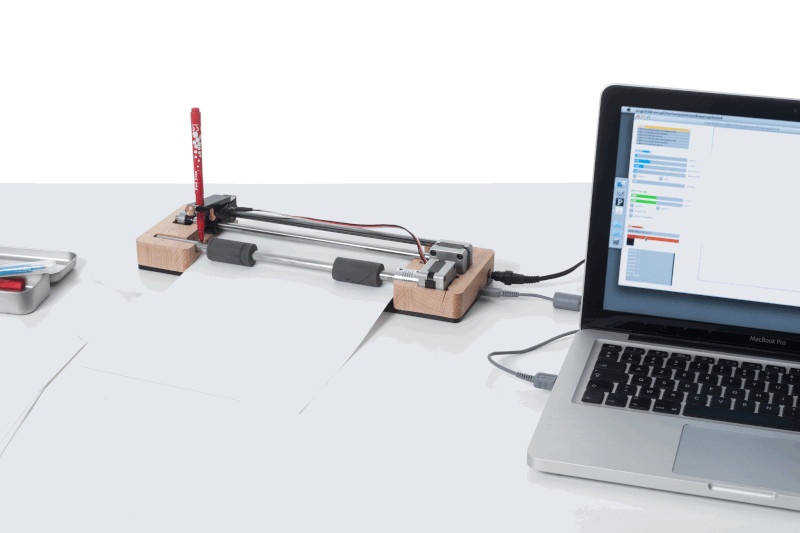Like many of us, [Benjamin Poilve] was fascinated when he took apart a broken printer. He kept the parts, but unlike most of us, he did something with them, building a neat little plotter called the Liplo. Most pen plotters work by moving the pen on two axes, but [Benjamin] took a different approach, using the friction drive bars from the printer to move the paper on one axis, and a servo to move the pen on the other. He’s refined the design from its initial rough state to create a very refined final product that uses a combination of salvaged, 3D-printed, and CNC-milled parts.
The Liplo is driven by a Teensy 3.1 and an Eibot board to drive the motors. [Benjamin] was planning to offer the plotter a kit on Kickstarter, but life got in the way. His loss is our gain, as he is now offering the plans and code for this neat build for free. If this one doesn’t plot your desires, we’ve seen lots of other home built plotters recently, including this one made from a 3D printer, and even one made of cardboard.















I scored an HP 7475a plotter cheap. I got it working but then what? It’s really not useful for anything. It’s fun to watch (once or twice) but it’s painfully slow for printing anything, and it’s lower quality than modern inkjets.
So now it’s just gathering dust.
Would you be able to modify it to use a drag knife? That opens up vinyl work.
Perhaps, but it would surely be lower quality than a cheap vinyl cutter.
whine whine! Those guys are getting increasingly hard to find. Mine wound-up being a hard-learnt lesson in getting help packing for a move. Nearly a decade ago, and there are still times I cringe at its loss. You don’t want it, I’m sure someone does. A great learning-tool for aspiring nerds, anyhow! Throw in an arduino and [serial] wacom-tablet.
OTOH, this build is pretty slick.
I never figured out what I’d do with a small bed plotter. But the ones that have one indefinitely long axis are kinda fun.
Are you looking to sell it?
As long as you have an RS232 port and the system software can have raw ASCII thrown at it, you can run any HPGL plotter. In Microsoft systems you just use the COPY command to send the text *.PLT files to the serial port.
Dunno if HPGL/2 is that easy, I never had a plotter that spoke HPGL/2.
I had a HP 7475 and used it to plot a few patterns to cut layers of masonite to glue together for a project. After that I didn’t use it again so I sold it for the same $1 I paid for it at an electronics junk/salvage shop. If it had been the 7475A model with the pen carousel I might have kept it.
I used to hand edit (well, I quickly wrote some scripts once I started) HPGL al the time, it’s pretty easy.
I am an artist. I am trying to find a way to plot drawings on canvas. This may do it.
I have an HP7475 in my collection/hoard – I would hate to see it go.
I remember someone once mentioning using them as a way to paint resist onto circuit boards to prepare boards for etching – but I never worked out what they were using as an actual ink that the pens would not bleed to clog up with,
It’s a pity that the pens are pretty much impossible to find – does anyone have any tips or suggestions as to sources of working pens or ways to reliably re-ink them?
They’re actually easy to buy. Just google for “hp 7475a plotter pens”. They’re not cheap, but they’re easy … uh … to buy that is.
https://www.youtube.com/watch?v=h-oj4HrTH14
(some other suggestions in the comments there too)
Putting this out there for someone smarter than I (at least with software) — I was inspired, a few years ago, by the story on here about a former Soviet homemade printer that worked similar to this, as a single-pin dot-matrix device. My idea was to combine an eBay solenoid with the guts of a cheap inkjet to produce a braille impressor printer on the cheap. I never could get my head around the software end, though, so if someone wants to take up the idea — it’s yours, good luck.
Nice work. Recently I built a similar plotter – https://www.thingiverse.com/thing:3340918
What I’d use it for is making pencil templates of photos that have been filtered using an edge detect filter so only contours are visible. I would plot it on to aquarel/water color paper. In the family there are plenty people who want to paint using that template :)
If the plotter is larger than A4, you can plot designs for cutting wood or aluminium larger than what a regular 2D printer can do.
A real time earth tremor plotter is also possible using an accelerometer or weighed down piezo inducer, a microcontroller with an adc.
it really is not about how useful a thing might be (I’m sure the [Benjamin Poilve] had a need), but the fact that you can make it. these things use to sell for thousand of dollars now with a little knowledge you can build it out of junk for next to nothing. and who knows somebody out there may have a need for something like this and now knows how to accomplish it.
“it really is not about how useful a thing might be, but the fact that you can make it”: There are lots of things that are challenging and fun to make. How does one decide which of them to make? I, for one, prioritize based on whether I’d find it useful.